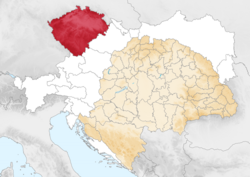
Kingdom of Bohemia
Monarchy in Central Europe (1198–1918), predecessor of modern Czechia / From Wikipedia, the free encyclopedia
Dear Wikiwand AI, let's keep it short by simply answering these key questions:
Can you list the top facts and stats about Kingdom of Bohemia?
Summarize this article for a 10 year old
The Kingdom of Bohemia (Czech: České království),[lower-alpha 1] sometimes referenced in English literature as the Czech Kingdom,[9][10][lower-alpha 1] was a medieval and early modern monarchy in Central Europe. It was the predecessor state of the modern Czech Republic.
This article may need to be rewritten to comply with Wikipedia's quality standards, as it is hard to read, lacking citations, and has sections that should be reorganized. (July 2023) |
Kingdom of Bohemia | |||||||||||||||||
|---|---|---|---|---|---|---|---|---|---|---|---|---|---|---|---|---|---|
| 1198–1918 | |||||||||||||||||
| Medieval, royal shield of the King of Bohemia as imperial Elector and Arch-Cupbearer:[3][4] | |||||||||||||||||
 The Kingdom of Bohemia (dark red) with other Bohemian Crown lands (light red) within the Holy Roman Empire (1618) | |||||||||||||||||
 The Kingdom of Bohemia (red) within Austria-Hungary (1914) | |||||||||||||||||
| Status |
| ||||||||||||||||
| Capital and largest city | Prague | ||||||||||||||||
| Common languages | |||||||||||||||||
| Religion |
| ||||||||||||||||
| Government | Feudal monarchy Absolute monarchy Parliamentary monarchy | ||||||||||||||||
| King | |||||||||||||||||
• 1198–1230 | Ottokar I (first) | ||||||||||||||||
• 1916–1918 | Charles III (last) | ||||||||||||||||
| History | |||||||||||||||||
• Kingdom established | 1198 | ||||||||||||||||
• Hereditary royal title confirmed | 26 September 1212 | ||||||||||||||||
• Inauguration of the Luxembourg dynasty | December 1310 | ||||||||||||||||
• Became main part of the Crown of Bohemia | 7 April 1348 | ||||||||||||||||
| 25 December 1356 | |||||||||||||||||
| 16 December 1526 | |||||||||||||||||
• Renewed Land Ordinance imposed hereditary Habsburg succession to throne | 10 May 1627 | ||||||||||||||||
• Crown of Bohemia de facto dissolved | 1 May 1749 | ||||||||||||||||
• Dissolution of Austria-Hungary | 31 October 1918 | ||||||||||||||||
| Population | |||||||||||||||||
| Approximately 2 million | |||||||||||||||||
| Currency | |||||||||||||||||
| |||||||||||||||||
| Today part of | Czech Republic Germany Poland Slovakia | ||||||||||||||||
The Kingdom of Bohemia was an Imperial State in the Holy Roman Empire. The Bohemian king was a prince-elector of the empire. The kings of Bohemia, besides the region of Bohemia itself, also ruled other lands belonging to the Bohemian Crown, which at various times included Moravia, Silesia, Lusatia, and parts of Saxony, Brandenburg, and Bavaria.[citation needed]
The kingdom was established by the Přemyslid dynasty in the 12th century by the Duchy of Bohemia, later ruled by the House of Luxembourg, the Jagiellonian dynasty, and from 1526 the House of Habsburg and its successor, the House of Habsburg-Lorraine. Numerous kings of Bohemia were also elected Holy Roman Emperors, and the capital, Prague, was the imperial seat in the late 14th century, and again at the end of the 16th and the beginning of the 17th centuries.
Shortly before the dissolution of the Holy Roman Empire in 1806, the kingdom became part of the newly proclaimed Habsburg Austrian Empire, and subsequently the Austro-Hungarian Empire from 1867. Bohemia retained its name and formal status as a separate Kingdom of Bohemia until 1918, known as a crown land within the Austro-Hungarian Empire, and its capital Prague was one of the empire's leading cities. The Czech language (called the Bohemian language in English usage until the 19th century)[11] was the main language of the Diet and the nobility until 1627 (after the Bohemian Revolt was suppressed). German was then formally made equal with Czech and eventually prevailed as the language of the Diet until the Czech National Revival in the 19th century. German was also widely used as the language of administration in many towns after the Germans immigrated and populated some areas of the country in the 13th century. The royal court used the Czech, Latin, and German languages, depending on the ruler and period.
Following the defeat of the Central Powers in World War I, both the Kingdom and Empire were dissolved. Bohemia became the core part of the newly formed Czechoslovak Republic.



